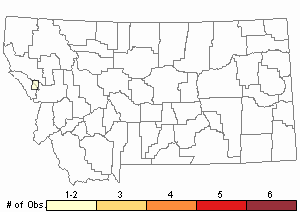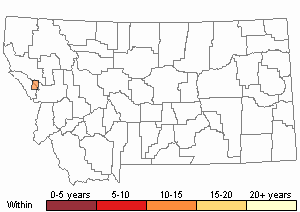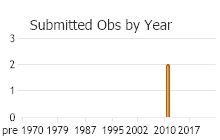View in other NatureServe Network Field Guides
NatureServe
Montana
Utah
Wyoming
Idaho
Wisconsin
British Columbia
South Carolina
Yukon
California
New York
Utah Needlefly - Perlomyia utahensis
Native Species
Global Rank:
G3
State Rank:
SNR
(see State Rank Reason below)
Agency Status
USFWS:
USFS:
BLM:
External Links
State Rank Reason (see State Rank above)
Currently unranked, but given this species is a G3, it may wind up on MT's SOC list given limited sites and abundance where found.
General Description
This is a small black stonefly in the family; Leuctridae. Like most of the species in the rolled-winged family, this species hatches early in the year often when snow is still on the ground, where they can be noticed quite easily crawling around along the banks of streams.
Phenology
Emergence occurs from April through July (Baumann, Gaufin, and Surdick 1977). Hoppe (1938) and R. Newell (pers. comm.) found males and females in copula in mid-May at White Horse Mt, Washington and western Montana, respectively.
Diagnostic Characteristics
Adult male morphology: “Length to tip of wings 11 mm. Expanse 19 mm. General color dark brown. Head blackish, little wider than prothorax, covered with white pile; a transverse depressed area jut back of hind ocelli; the hind ocelli about three times as close to the eyes as to each other; antennae brown; maxillary palpi very large. Prothorax blackish brown, distinctly longer than wide; slightly narrowed behind; front margin rounded; sides straight, surface rugose, the rugosity black. Legs brown. Middle tarsal segment short; first tarsal segment of meso and metathoracic segments longer than third. Wings uniformly subhyaline with reddish or rusty tinge; veins brown. Abdomen brown. Cerci chitinized with a small black spur at the tip and a large black tooth at the base pointing upward” (Needham and Claassen 1925).
Range Comments
This species has a wide distribution, including California, Colorado, Montana, New Mexico, Oregon, Utah, Idaho, Alberta, and British Columbia (NatureServe 2006). The Idaho distribution comprises 2 locations in Latah County and just a couple known locations in Montana on the western side of the state.
Observations in Montana Natural Heritage Program Database
Number of Observations: 2
(Click on the following maps and charts to see full sized version)
Map Help and Descriptions
Relative Density

Recency



 (Observations spanning multiple months or years are excluded from time charts)
(Observations spanning multiple months or years are excluded from time charts)
Habitat
Ecology: This species inhabits creeks and small rivers but is most common in springs (Baumann, Gaufin, and Surdick 1977).
Food Habits
Merritt and Cummins (1996) report that members of this family are trophically shredder-detritivores; eating large particulate organic materials such as detritus, leaves and plants.
Ecology
Ecology: This species inhabits creeks and small rivers but is most common in springs (Baumann, Gaufin, and Surdick 1977).
Reproductive Characteristics
Emergence occurs from April through July (Baumann, Gaufin, and Surdick 1977). Hoppe (1938) found males and females in copula in mid-May at White Horse Mt., Washington.
Threats or Limiting Factors
Specific threats to Montana populations of P. utahensis have not been identified. In general, stonefly populations are affected by changes to aquatic habitat such as alteration of flow patterns, streambed substrate, thermal characteristics, and water quality. Alteration and degredation of aquatic habitats or water quality are the primary concern for Montana populations.
References
- Literature Cited AboveLegend:
 View Online Publication
View Online Publication Baumann, R.W, A.R. Gaufin, and R.F. Surdick. 1977. The stoneflies (Plecoptera) of the Rocky Mountains. American Entomological Society, Philadelphia.
Baumann, R.W, A.R. Gaufin, and R.F. Surdick. 1977. The stoneflies (Plecoptera) of the Rocky Mountains. American Entomological Society, Philadelphia. NatureServe. 2006. NatureServe Explorer: An online encyclopedia of life [web application]. Version 6.1. NatureServe, Arlington, Virginia.
NatureServe. 2006. NatureServe Explorer: An online encyclopedia of life [web application]. Version 6.1. NatureServe, Arlington, Virginia.
- Additional ReferencesLegend:
 View Online Publication
View Online Publication
Do you know of a citation we're missing? Cummins, K.W. and R.W. Merritt. 1996. Ecology and distribution of aquatic insects. Chapter 6, pages 74-86 in R.W. Merritt and K.W. Cummins (eds.) An Introduction to the Aquatic Insects of North America. Third Edition. Kendall/Hunt Publishing Company, Dubuque, Iowa. 862 pp.
Cummins, K.W. and R.W. Merritt. 1996. Ecology and distribution of aquatic insects. Chapter 6, pages 74-86 in R.W. Merritt and K.W. Cummins (eds.) An Introduction to the Aquatic Insects of North America. Third Edition. Kendall/Hunt Publishing Company, Dubuque, Iowa. 862 pp. Gustafson, D. L. 1990. Ecology of aquatic insects in the Gallatin River drainage. Ph.D. Dissertation. Bozeman, MT: Montana State University. 194 p.
Gustafson, D. L. 1990. Ecology of aquatic insects in the Gallatin River drainage. Ph.D. Dissertation. Bozeman, MT: Montana State University. 194 p.
- Web Search Engines for Articles on "Utah Needlefly"
- Additional Sources of Information Related to "Insects"





